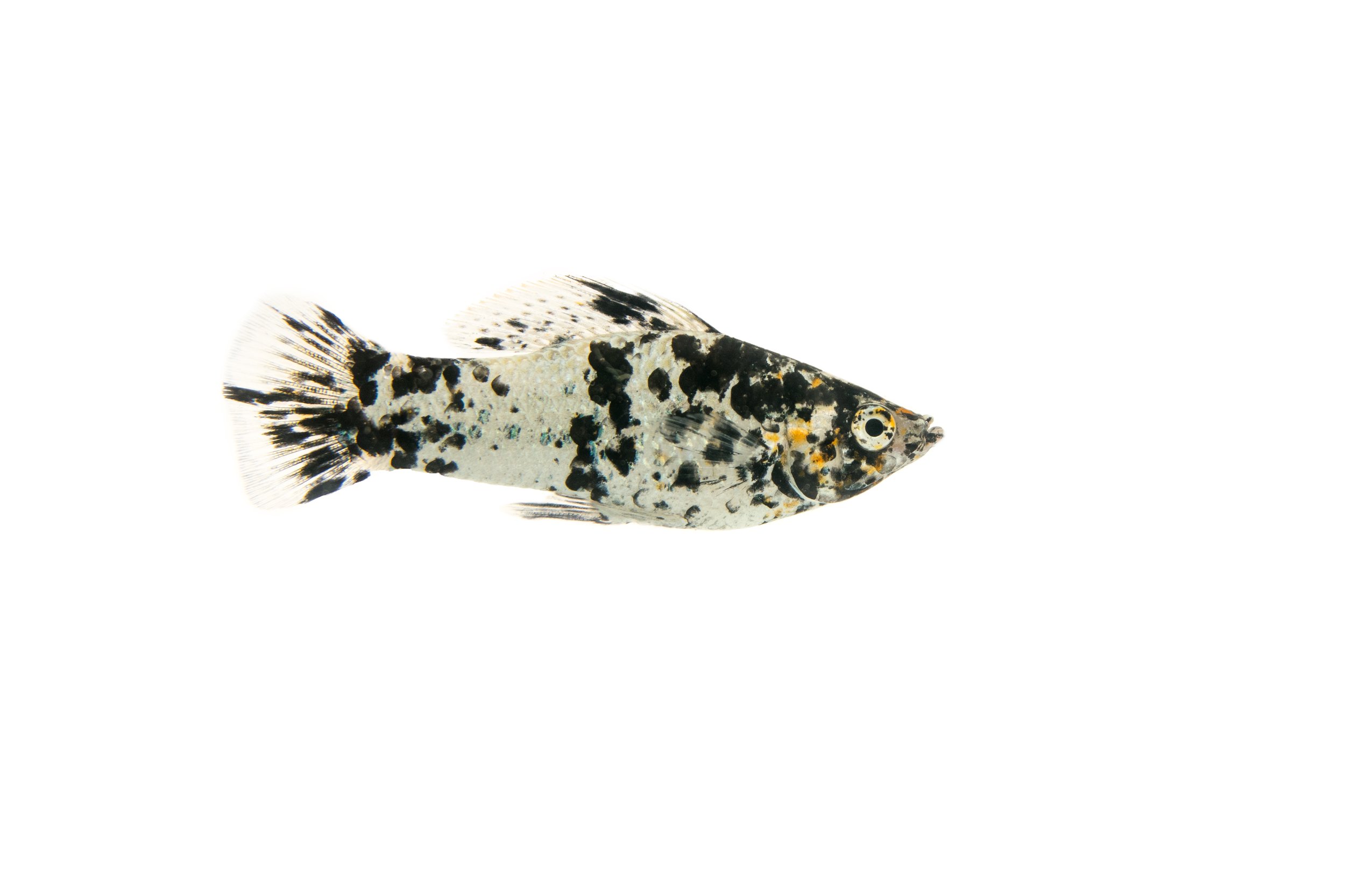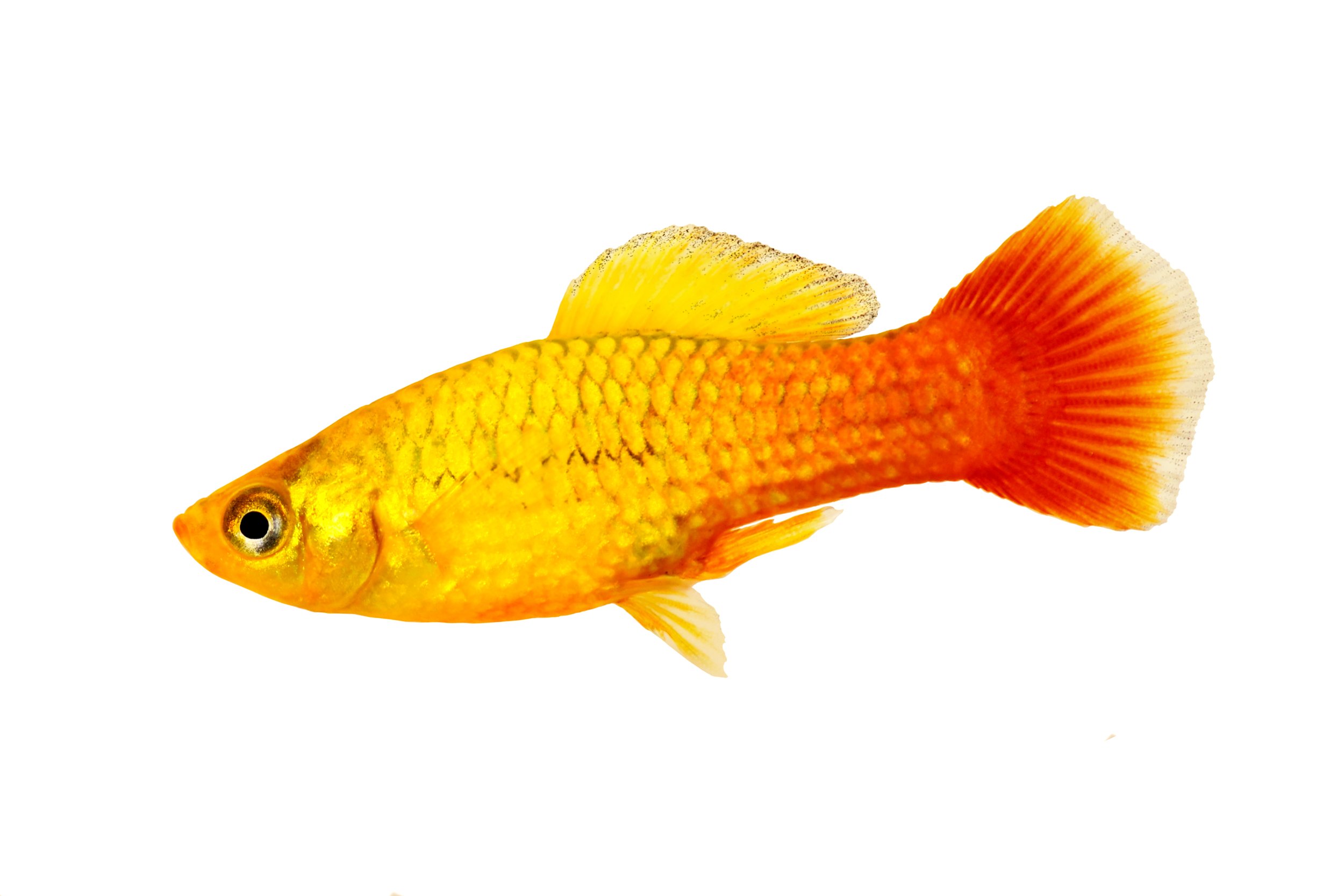 Image 1 of
Image 1 of


Dalmation Molly-S Locally Bred
The Common Molly, scientifically known as Poecilia sphenops, is a popular livebearing fish native to Central America. It inhabits a variety of freshwater environments, including rivers, streams, and coastal areas. Mollies are known for their hardiness, peaceful nature, and adaptability, making them a favorite among aquarists.
Adult Common Mollies typically reach about 3 to 4 inches (7.5 to 10 cm) in length. They exhibit a range of colors and patterns, including black, gold, silver, and dalmatian. Males are generally smaller and more slender, with a gonopodium (modified anal fin), while females are larger and have a fan-shaped anal fin.
A tank of at least 20 gallons is recommended for a small group of Common Mollies. They are social fish and thrive in groups, so keeping them in numbers helps reduce stress and encourages natural behavior. The aquarium should have a sandy or fine gravel substrate, ample swimming space, and decorations such as plants and driftwood to provide hiding spots and mimic their natural environment.
Water parameters for Common Mollies should include a temperature range of 75 to 80°F (24 to 27°C), a pH between 7.5 and 8.5, and moderate to high hardness. They are adaptable to various water conditions but prefer stable environments. Regular water changes and good filtration are essential to maintain water quality.
Feeding Common Mollies is straightforward, as they are omnivorous and accept a variety of foods. Offer high-quality flakes or pellets as a staple diet, and supplement with live or frozen foods like brine shrimp or bloodworms. They also require vegetable matter in their diet, so include algae wafers or blanched vegetables.
Common Mollies are peaceful and do well in community tanks with other non-aggressive fish such as tetras, guppies, and platies. Avoid keeping them with larger or more aggressive species that may intimidate them.
Common Mollies are livebearers and breed readily in captivity. Females give birth to live young, and a separate breeding tank with plenty of hiding spots can increase fry survival rates. Adults may eat their own young, so it’s important to provide cover or remove adults after birth.
Poecilia sphenops (Common Molly) is a hardy and adaptable species that adds vibrant color and activity to community aquariums. With proper care and attention to their specific needs, they can be a rewarding addition for aquarists of all experience levels.
The Common Molly, scientifically known as Poecilia sphenops, is a popular livebearing fish native to Central America. It inhabits a variety of freshwater environments, including rivers, streams, and coastal areas. Mollies are known for their hardiness, peaceful nature, and adaptability, making them a favorite among aquarists.
Adult Common Mollies typically reach about 3 to 4 inches (7.5 to 10 cm) in length. They exhibit a range of colors and patterns, including black, gold, silver, and dalmatian. Males are generally smaller and more slender, with a gonopodium (modified anal fin), while females are larger and have a fan-shaped anal fin.
A tank of at least 20 gallons is recommended for a small group of Common Mollies. They are social fish and thrive in groups, so keeping them in numbers helps reduce stress and encourages natural behavior. The aquarium should have a sandy or fine gravel substrate, ample swimming space, and decorations such as plants and driftwood to provide hiding spots and mimic their natural environment.
Water parameters for Common Mollies should include a temperature range of 75 to 80°F (24 to 27°C), a pH between 7.5 and 8.5, and moderate to high hardness. They are adaptable to various water conditions but prefer stable environments. Regular water changes and good filtration are essential to maintain water quality.
Feeding Common Mollies is straightforward, as they are omnivorous and accept a variety of foods. Offer high-quality flakes or pellets as a staple diet, and supplement with live or frozen foods like brine shrimp or bloodworms. They also require vegetable matter in their diet, so include algae wafers or blanched vegetables.
Common Mollies are peaceful and do well in community tanks with other non-aggressive fish such as tetras, guppies, and platies. Avoid keeping them with larger or more aggressive species that may intimidate them.
Common Mollies are livebearers and breed readily in captivity. Females give birth to live young, and a separate breeding tank with plenty of hiding spots can increase fry survival rates. Adults may eat their own young, so it’s important to provide cover or remove adults after birth.
Poecilia sphenops (Common Molly) is a hardy and adaptable species that adds vibrant color and activity to community aquariums. With proper care and attention to their specific needs, they can be a rewarding addition for aquarists of all experience levels.
The Common Molly, scientifically known as Poecilia sphenops, is a popular livebearing fish native to Central America. It inhabits a variety of freshwater environments, including rivers, streams, and coastal areas. Mollies are known for their hardiness, peaceful nature, and adaptability, making them a favorite among aquarists.
Adult Common Mollies typically reach about 3 to 4 inches (7.5 to 10 cm) in length. They exhibit a range of colors and patterns, including black, gold, silver, and dalmatian. Males are generally smaller and more slender, with a gonopodium (modified anal fin), while females are larger and have a fan-shaped anal fin.
A tank of at least 20 gallons is recommended for a small group of Common Mollies. They are social fish and thrive in groups, so keeping them in numbers helps reduce stress and encourages natural behavior. The aquarium should have a sandy or fine gravel substrate, ample swimming space, and decorations such as plants and driftwood to provide hiding spots and mimic their natural environment.
Water parameters for Common Mollies should include a temperature range of 75 to 80°F (24 to 27°C), a pH between 7.5 and 8.5, and moderate to high hardness. They are adaptable to various water conditions but prefer stable environments. Regular water changes and good filtration are essential to maintain water quality.
Feeding Common Mollies is straightforward, as they are omnivorous and accept a variety of foods. Offer high-quality flakes or pellets as a staple diet, and supplement with live or frozen foods like brine shrimp or bloodworms. They also require vegetable matter in their diet, so include algae wafers or blanched vegetables.
Common Mollies are peaceful and do well in community tanks with other non-aggressive fish such as tetras, guppies, and platies. Avoid keeping them with larger or more aggressive species that may intimidate them.
Common Mollies are livebearers and breed readily in captivity. Females give birth to live young, and a separate breeding tank with plenty of hiding spots can increase fry survival rates. Adults may eat their own young, so it’s important to provide cover or remove adults after birth.
Poecilia sphenops (Common Molly) is a hardy and adaptable species that adds vibrant color and activity to community aquariums. With proper care and attention to their specific needs, they can be a rewarding addition for aquarists of all experience levels.





